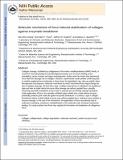Molecular mechanism of force induced stabilization of collagen against enzymatic breakdown
Author(s)
Chang, Shu-Wei; Flynn, Brendan P.; Ruberti, Jeffrey W.; Buehler, Markus J
DownloadBuehler_Molecular mechanism.pdf (1.274Mb)
PUBLISHER_CC
Publisher with Creative Commons License
Creative Commons Attribution
Terms of use
Metadata
Show full item recordAbstract
Collagen cleavage, facilitated by collagenases of the matrix metalloproteinase (MMP) family, is crucial for many physiological and pathological processes such as wound healing, tissue remodeling, cancer invasion and organ morphogenesis. Earlier work has shown that mechanical force alters the cleavage rate of collagen. However, experimental results yielded conflicting data on whether applying force accelerates or slows down the degradation rate. Here we explain these discrepancies and propose a molecular mechanism by which mechanical force might change the rate of collagen cleavage. We find that a type I collagen heterotrimer is unfolded in its equilibrium state and loses its triple helical structure at the cleavage site without applied force, possibly enhancing enzymatic breakdown as each chain is exposed and can directly undergo hydrolysis. Under application of force, the naturally unfolded region refolds into a triple helical structure, potentially protecting the molecule against enzymatic breakdown. In contrast, a type I collagen homotrimer retains a triple helical structure even without applied force, making it more resistant to enzyme cleavage. In the case of the homotrimer, the application of force may directly lead to molecular unwinding, resulting in a destabilization of the molecule under increased mechanical loading. Our study explains the molecular mechanism by which force may regulate the formation and breakdown of collagenous tissue.
Date issued
2012-03Department
Massachusetts Institute of Technology. Center for Materials Science and Engineering; Massachusetts Institute of Technology. Center for Computational Engineering; Massachusetts Institute of Technology. Department of Civil and Environmental Engineering; Massachusetts Institute of Technology. Laboratory for Atomistic and Molecular MechanicsJournal
Biomaterials
Publisher
Elsevier
Citation
Chang, Shu-Wei, Brendan P. Flynn, Jeffrey W. Ruberti, and Markus J. Buehler. “Molecular Mechanism of Force Induced Stabilization of Collagen Against Enzymatic Breakdown.” Biomaterials 33, no. 15 (May 2012): 3852–3859.
Version: Author's final manuscript
ISSN
01429612
1878-5905